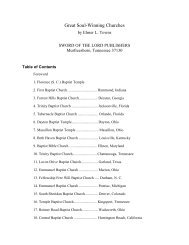PUTTING AN END TO WORSHIP WARS - Elmer Towns
PUTTING AN END TO WORSHIP WARS - Elmer Towns
PUTTING AN END TO WORSHIP WARS - Elmer Towns
- TAGS
- worship
- elmer
- towns
- elmertowns.com
Create successful ePaper yourself
Turn your PDF publications into a flip-book with our unique Google optimized e-Paper software.
THE STRENGTHS <strong>AN</strong>D CONTRIBUTIONS OF THE CONGREGATIONAL<br />
CHURCH<br />
The Congregational Church makes a significant contribution to church life in America<br />
especially in the area of lay involvement. A member of one Congregational Church of only five<br />
families commented, "God has really blessed our church in that all our families tithe." The<br />
sacrificial giving of these five families was sufficient to enable this small church to maintain a<br />
church facility, pay a pastor's salary and maintain the home in which his family lived. In a<br />
Congregational Church, it is not uncommon to find every member involved in some ministry.<br />
Often, many members are involved in several, perhaps too many ministries.<br />
The size of the Congregational Church is certainly a factor in the high membership<br />
involvement ratio characterizing these churches, but size alone is not a sufficient explanation for<br />
this phenomenon. Many members of Congregational Churches see their size as a hinderance to<br />
attracting new families to become involved. Members of Congregational Churches are involved<br />
in church ministries because they have bought into the vision of their church and taken<br />
ownership of the ministry. When this happens, people become increasingly more involved in<br />
ministry, regardless of the size of the church.<br />
A second strength of the Congregational Church is the achievement of balance in<br />
ministry. It is true many Congregational Churches are reluctant to try new ministries, but over<br />
the years these congregations have evolved a ministry that balances the worship of God with the<br />
study of the Word of God. A second area of balance developed by these churches is that of<br />
outreach evangelistic ministries with ministries directed toward the members of the church itself.<br />
While balance appears to have emerged without direction in many Congregational<br />
Churches, it has probably occurred because of the blend of giftedness within the church. Unlike<br />
other worship styles, this church is not tied to a single spiritual gift but rather includes members<br />
exercising all the spiritual gifts. Like the church at Corinth, they "come short in no gift" (1 Cor.<br />
1:7). As each gifted member exercises his or her influence within the church, a balance emerges<br />
that makes room for all gifts. The example of the Congregational Church in this area stands as a<br />
challenge to other church types.<br />
THE WEAKNESSES OF THE CONGREGATIONAL CHURCH<br />
Despite these strengths, Congregational Churches tend not to experience significant<br />
numerical growth. These growth limitations are directly tied to sociological factors which define<br />
the nature of this church type. So long as a Congregational Church remains tied to a single cell<br />
church model, church growth will be limited to the maximum size of that cell, i.e. forty to sixtysix<br />
people. The Congregational Church may work hard to build attendance to a hundred or more,<br />
but without changing the infrastructure of their church, they will experience a decline in<br />
attendance. The key to increasing the size of a Congregational Church is to multiply cells.<br />
In the early part of this century, Arthur Flake encouraged the growth of single-celled<br />
churches through a plan that multiplied cells within churches which tended to be Congregational<br />
Churches. His recommendations called for organizing their programs for outreach, enlisting
















